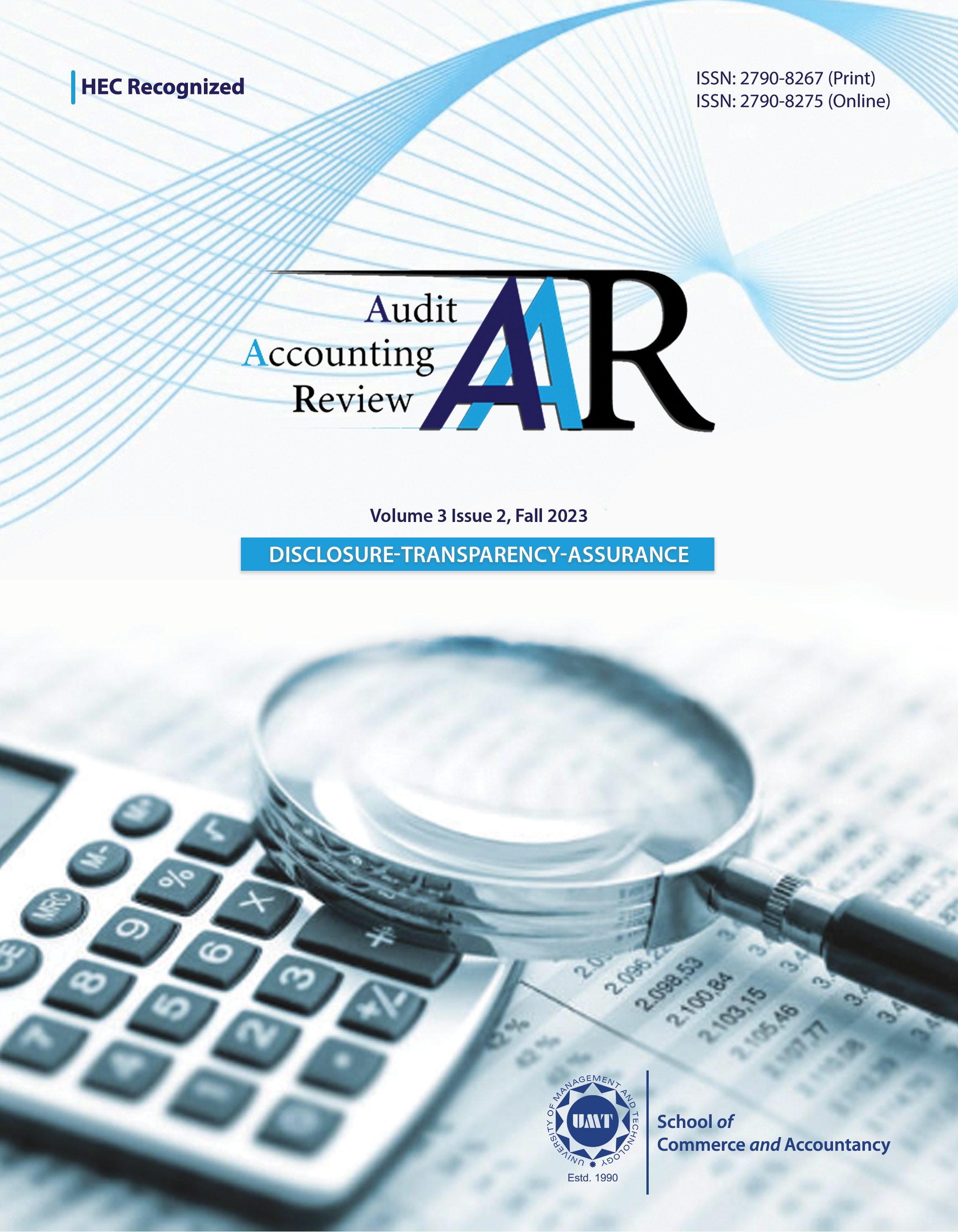Estimating Cost Efficiency Function and Market Power Indicators of Commercial Banks: An Empirical Study of Iraq
Abstract
 Abstract Views: 0
Abstract Views: 0
Even though the commercial banks in Iraq faced various issues, especially after the banking sector in Iraq gained recognition in 2004. The scarcity of empirical evidence on the real issues facing the banking sector makes it difficult for decision-makers and policymakers to take adequate measures to address potential problems. This paper contributes to the empirical literature by measuring and analyzing cost efficiency in addition to the Lerner index to measure the power of the banking market in Iraq. A sample of panel data is utilized from 20 Iraqi commercial banks for the period 2010-2020. The data envelope analysis DEA is used to measure banks’ cost efficiency. The empirical results gave evidence of a decrease in the price cost efficiency index in the banking sector during the transitional period, and the Lerner index gave negative results, which is an indication of the decline in the market power of Iraqi banks. This paper suggests that studies should be expanded to measure the power and weaknesses of the banking sector, which led to a decrease in the cost-price efficiency and the strength of the behavior.
Downloads
References
Adjei-Frimpong, K., Gan, C., & Hu, B. (2014). Cost efficiency of Ghana’s banking industry: Panel data analysis. The International Journal of Business and Finance Research, 8(2), 69–86. https://ssrn.com/abstract=2322961
Ahn, H., & Le, M. H. (2014). An insight into the specification of the input-output set for DEA-based bank efficiency measurement. Management Review Quarterly, 64, 3–37. https://doi.org/10.1007/s11301-013-0098-9
Akhavein, J. D., Berger, A. N., & Humphrey, D. B. (1997). The effects of megamergers on efficiency and prices: Evidence from a bank profit function. Review of Industrial Organization, 12, 95–139. https://doi.org/10.1023/A:1007760924829
An, Q., Tao, X., & Xiong, B. (2021). Benchmarking with data envelopment analysis: An agency perspective. Omega, 101(2), Article e102235. https://doi.org/10.1016/j.omega.2020.102235
Amel, D., Barnes, C., Panetta, F., & Salleo, C. (2004). Consolidation and efficiency in the financial sector: A review of the international evidence. Journal of Banking & Finance, 28(10), 2493–2519. https://doi.org/10.1016/j.jbankfin.2003.10.013
Anwar, M. (2019). Cost efficiency performance of Indonesian banks over the recovery period: A stochastic frontier analysis. The Social Science Journal, 56(3), 377–389. https://doi.org/10.1016/j.soscij.2018.08.002
Ariss, R. T. (2010). On the implications of market power in banking: Evidence from developing countries. Journal of Banking & Finance, 34(4), 765–775. https://doi.org/10.1016/j.jbankfin.2009.09.004
Asaftei, G., & Kumbhakar, S. C. (2008). Regulation and efficiency in transition: The case of Romanian banks. Journal of Regulatory Economics, 33, 253–282. https://doi.org/10.1007/s11149-007-9041-0
Bain, J. S. (1956). Advantages of the large firm: Production, distribution, and sales promotion. Journal of Marketing, 20(4), 336–346. https://doi.org/10.1177/002224295602000402
Banker, R. D., Charnes, A., & Cooper, W. W. (1984). Some models for estimating technical and scale inefficiencies in data envelopment analysis. Management Science, 30(9), 1078–1092. https://doi.org/10.1287/mnsc.30.9.1078
Berger, A. N., & DeYoung, R. (1997). Problem loans and cost efficiency in commercial banks. Journal of Banking & Finance, 21(6), 849–870. https://doi.org/10.1016/S0378-4266(97)00003-4
Berger, A. N., Hancock, D., & Humphrey, D. B. (1993). Bank efficiency derived from the profit function. Journal of Banking & Finance, 17(2–3), 317–347. https://doi.org/10.1016/0378-4266(93)90035-C
Berger, A. N., & Humphrey, D. B. (1997). Efficiency of financial institutions: International survey and directions for future research. European Journal of Operational Research, 98(2), 175–212. https://doi.org/10.1016/S0377-2217(96)00342-6
Biswas, S. S. (2019). Creditor rights and the market power-stability relationship in banking. Journal of Financial Stability, 40, 53–63. https://doi.org/10.1016/j.jfs.2017.10.001
Blankson, N., Anarfo, E. B., Amewu, G., & Doabil, L. (2022). Examining the determinants of bank efficiency in transition: Empirical evidence from Ghana. Heliyon, 8(8), Article e10156. https://doi.org/10.1016/j.heliyon.2022.e10156
Borodin, A., Sayabek, Z. S., Islyam, G., & Panaedova, G. (2020). Impact of mergers and acquisitions on companies’ financial performance. Journal of International Studies, 13(2), 32–47. https://doi.org/10.14254/2071-8330.2020/13-2/3
Charnes, A., Cooper, W. W., Lewin, A. Y., & Seiford, L. M. (1994). Data envelopment analysis: Theory, methodology and applications. Spinger.
Charnes, A., Cooper, W. W., & Rhodes, E. (1978). Measuring the efficiency of decision making units. European Journal of Operational Research, 2(6), 429–444. https://doi.org/10.1016/0377-2217(78)90138-8
Chick, V. (1993). The evolution of the banking system and the theory of monetary policy. In S. F. Frowen (Ed.), Monetary theory and monetary policy. Palgrave Makmillan. https://doi.org/10.1007/978-1-349-23096-9_6
Clerides, S., Delis, M. D., & Kokas, S. (2015). A new data set on competition in national banking markets. Financial Markets, Institutions & Instruments, 24(2-3), 267–311. https://doi.org/10.1111/fmii.12030
Coccorese, P. (2014). Estimating the Lerner index for the banking industry: A stochastic frontier approach. Applied Financial Economics, 24(2), 73–88. https://doi.org/10.1080/09603107.2013.866202
Cowling, K., & Waterson, M. (1976). Price-cost margins and market structure. Economica, 43(171), 267–274. https://doi.org/10.2307/2553125
Cuesta, R. A., & Orea, L. (2002). Mergers and technical efficiency in Spanish savings banks: A stochastic distance function approach. Journal of Banking & Finance, 26(12), 2231–2247. https://doi.org/10.1016/S0378-4266(01)00184-4
Djalilov, K., & Piesse, J. (2019). Bank regulation and efficiency: Evidence from transition countries. International Review of Economics & Finance, 64, 308–322. https://doi.org/10.1016/j.iref.2019.07.003
Dow, S. C., Ghosh, D., & Ruziev, K. (2008). A stages approach to banking development in transition economies. Journal of Post Keynesian Economics, 31(1), 3–33.
Edgeworth, F. Y. (1881). Mathematical psychics: An essay on the application of mathematics to the moral sciences (Vol. 10). CK Paul.
Edwards, F., & Mishkin, F. S. (1993). The decline in the traditional role of banks: implications for financial stability and regulatory policy (National Bureau of Economic Research Working Paper No. w4993). https://papers.ssrn.com/sol3/papers.cfm?abstract_id=226591
Edwards, S., Allen, A. J., & Shaik, S. (2006). Market structure conduct performance (SCP) hypothesis revisited using stochastic frontier efficiency analysis. Agricultural and Applied Economics Association (AAEA). https://ideas.repec.org/p/ags/aaea06/21350.html
Elzinga, K. G., & Mills, D. E. (2011). The Lerner index of monopoly power: Origins and uses. American Economic Review, 101(3), 558–564. https://doi.org/10.1257/aer.101.3.558
Fakhfekh, M., Hachicha, N., Jawadi, F., Selmi, N., & Cheffou, A. I. (2016). Measuring volatility persistence for conventional and Islamic banks: An FI-EGARCH approach. Emerging Markets Review, 27, 84–99. https://doi.org/10.1016/j.ememar.2016.03.004
Farrell, M. J. (1957). The measurement of productive efficiency. Journal of the Royal Statistical Society: Series A (General), 120(3), 253–281. https://doi.org/10.2307/2343100
Feng, G., & Wang, C. (2018). Why European banks are less profitable than US banks: A decomposition approach. Journal of Banking & Finance, 90, 1–16. https://doi.org/10.1016/j.jbankfin.2018.02.017
Fiorentino, E., Karmann, A., & Koetter, M. (2006). The cost efficiency of German banks: a comparison of SFA and DEA. SSRN. http://dx.doi.org/10.2139/ssrn.947340
Fries, S., & Taci, A. (2005). Cost efficiency of banks in transition: Evidence from 289 banks in 15 post-communist countries. Journal of Banking & Finance, 29(1), 55–81. https://doi.org/10.1016/j.jbankfin.2004.06.016
Fukuyama, H., & Weber, W. L. (2008). Estimating inefficiency, technological change and shadow prices of problem loans for regional banks and Shinkin banks in Japan. The Open Management Journal, 1(1), 1–11. https://doi.org/10.2174/1874948800801010001
Gilbert, R. A. (1984). Bank market structure and competition: A survey. Journal of Money, Credit and Banking, 16(4), 617–645. https://doi.org/10.2307/1992096
Giocoli, N. (2012). Who invented the Lerner index? Luigi Amoroso, the dominant firm model, and the measurement of market power. Review of Industrial Organization, 41, 181–191. https://doi.org/10.1007/s11151-012-9355-7
Goncharov, I., Ioannidou, V., & Schmalz, M. C. (2023). (Why) do central banks care about their profits? The Journal of Finance, 78(5), 2991–3045. https://doi.org/10.1111/jofi.13257
Hainz, C., Weill, L., & Godlewski, C. J. (2013). Bank competition and collateral: Theory and evidence. Journal of Financial Services Research, 44(2), 131–148. https://doi.org/10.1007/s10693-012-0141-3
Hasan, I., & Marton, K. (2003). Development and efficiency of the banking sector in a transitional economy: Hungarian experience. Journal of Banking & Finance, 27(12), 2249–2271. https://doi.org/10.1016/S0378-4266(02)00328-X
Havrylchyk, O. (2006). Efficiency of the Polish banking industry: Foreign versus domestic banks. Journal of Banking & Finance, 30(7), 1975–1996. https://doi.org/10.1016/j.jbankfin.2005.07.009
Hirata, W., & Ojima, M. (2020). Competition and bank systemic risk: New evidence from Japan's regional banking. Pacific-Basin Finance Journal, 60, Article e101283. https://doi.org/10.1016/j.pacfin.2020.101283
Jemric, I., & Vujcic, B. (2002). Efficiency of banks in Croatia: A DEA approach. Comparative Economic Studies, 44, 169–193. https://doi.org/10.1057/ces.2002.13
Julian, S. D., & Ofori‐dankwa, J. C. (2013). Financial resource availability and corporate social responsibility expenditures in a sub‐Saharan economy: The institutional difference hypothesis. Strategic Management Journal, 34(11), 1314–1330. https://doi.org/10.1002/smj.2070
Karim, M. Z. A., Chan, S., & Hassan, S. (2010). Bank efficiency and non-performing loans: Evidence from Malaysia and Singapore. Prague Economic Papers, 2, 118–132. https://doi.org/10.18267/j.pep.367
Kasman, A., & Yildirim, C. (2006). Cost and profit efficiencies in transition banking: The case of new EU members. Applied Economics, 38(9), 1079–1090. https://doi.org/10.1080/00036840600639022
Kasman, A. (2005). Efficiency and scale economies in transition economies: Evidence from Poland and the Czech Republic. Emerging Markets Finance and Trade, 41(2), 60–81.
Kumbhakar, S. C., & Lovell, C. K. (2003). Stochastic frontier analysis. Cambridge university press.
Kyj, L., & Isik, I. (2008). Bank x-efficiency in Ukraine: An analysis of service characteristics and ownership. Journal of Economics and Business, 60(4), 369–393. https://doi.org/10.1016/j.jeconbus.2007.05.002
Landes, W. M., & Posner, R. A. (1981). Market power in antitrust cases. Harvard L.
Lerner, A. P. (1934). The concept of monopoly and the measurement of monopoly power. Macmillan Education UK.
Memanova, T., & Mylonidis, N. (2020). Exploring the nexus between bank market power and exports. Economic Modelling, 84, 222–233. https://doi.org/10.1016/j.econmod.2019.04.012
Pruteanu-Podpiera, A., Weill, L., & Schobert, F. (2007). Market power and efficiency in the Czech banking sector. CNB.
Rakshit, B., & Bardhan, S. (2022). An empirical investigation of the effects of competition, efficiency and risk-taking on profitability: An application in Indian banking. Journal of Economics and Business, 118, Article e106022. https://doi.org/10.1016/j.jeconbus.2021.106022
Ray, S. C. (2004). Data envelopment analysis: Theory and techniques for economics and operations research. Cambridge university press.
Rossi, S. P. S., Schwaiger, M., & Winkler, G. (2005). Managerial behavior and cost/profit efficiency in the banking sectors of Central and Eastern European countries (Oesterreichische National Bank Working Paper No. 96). https://www.oenb.at/dam/jcr:0c81fef8-c381-4dc8-a527-7462da792b43/wp96_tcm16-27319.pdf
Sathye, M. (2003). Efficiency of banks in a developing economy: The case of India. European Journal of Operational Research, 148(3), 662–671. https://doi.org/10.1016/S0377-2217(02)00471-X
Saving, T. R. (1970). Concentration ratios and the degree of monopoly. International Economic Review, 11(1), 139–146. https://doi.org/10.2307/2525343
Sealey, C. W., Jr., & Lindley, J. T. (1977). Inputs, outputs, and a theory of production and cost at depository financial institutions. The Journal of Finance, 32(4), 1251–1266. https://doi.org/10.1111/j.1540-6261.1977.tb03324.x
Seiford, L. M., & Thrall, R. M. (1990). Recent developments in DEA: The mathematical programming approach to frontier analysis. Journal of Econometrics, 46(1–2), 7–38. https://doi.org/10.1016/0304-4076(90)90045-U
Shaffer, S., & Spierdijk, L. (2017). Market power: Competition among measures. In J. A. Bikker & L. Spierdijk (Ed.), Handbook of competition in banking and finance (pp. 11–26). Edward Elgar Publishing.
Shamshur, A., & Weill, L. (2019). Does bank efficiency influence the cost of credit? Journal of Banking & Finance, 105, 62–73. https://doi.org/10.1016/j.jbankfin.2019.05.002
Singh, P. (2009). Mergers in Indian banking: Impact study using DEA analysis. South Asian Journal of Management, 16(2). 7–27.
Singh, S., & Das, S. (2018). Impact of post-merger and acquisition activities on the financial performance of banks: A study of Indian private sector and public sector banks. Revista Espacios Magazine, 39(26), Article e25. https://doi.org/10.1177/23197145211053400
Spulbăr, C., & Niţoi, M. (2014). Determinants of bank cost efficiency in transition economies: Evidence for Latin America, Central and Eastern Europe and South-East Asia. Applied Economics, 46(16), 1940–1952. https://doi.org/10.1080/00036846.2014.889806
Tan, Y., & Floros, C. (2018). Risk, competition and efficiency in banking: Evidence from China. Global Finance Journal, 35, 223–236. https://doi.org/10.1016/j.gfj.2017.12.001
Vennet, R. V. (2002). Cost and profit efficiency of financial conglomerates and universal banks in Europe. Journal of Money, Credit and Banking, 34(1), 254–282. https://doi.org/10.1353/mcb.2002.0036
Zhao, B. (2019). Efficiency and productivity of Chinese national and regional banks [Doctoral dissertation, Loughborough University]. Loughborough University Repository. https://doi.org/10.26174/thesis.lboro.10315994.v1
Copyright (c) 2023 Bha Aldan Abdul Sattar Faraj, Gökhan Övenç

This work is licensed under a Creative Commons Attribution 4.0 International License.
Authors retain copyright and grant the journal right of first publication with the work simultaneously licensed under a Creative Commons Attribution (CC-BY) 4.0 License that allows others to share the work with an acknowledgement of the work’s authorship and initial publication in this journal.







